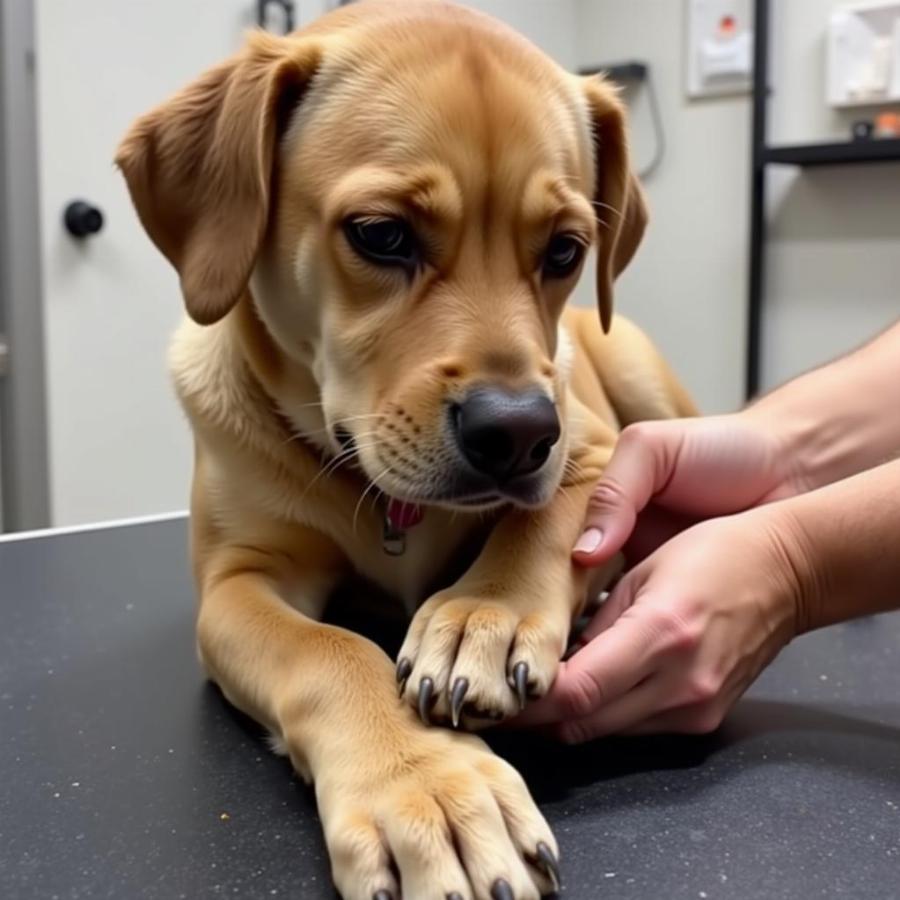Dog grooming positions are crucial for a safe and comfortable experience for both you and your furry friend. Understanding the right holds and techniques will not only make grooming more efficient but also help prevent injuries and build a positive association with the grooming process. Whether you’re a seasoned pet parent or just starting out, this guide will walk you through the essential dog grooming positions, ensuring a stress-free and successful grooming session every time.
Understanding the Importance of Proper Dog Grooming Positions
Why are dog grooming positions so important? Well, imagine trying to brush a wiggling puppy while he’s standing up! It’s a recipe for disaster. Correct positioning provides stability and control, allowing you to access all areas of your dog’s body effectively. It also minimizes stress for your dog, making grooming a more pleasant experience. Secure holds prevent sudden movements that could lead to accidental nicks or cuts during nail trimming or clipper work. By mastering these positions, you’ll foster trust and cooperation with your dog, transforming grooming time into a bonding experience.
Essential Dog Grooming Positions
Several key positions are fundamental to successful dog grooming. Each position is designed for specific grooming tasks and caters to different dog sizes and temperaments. Let’s explore these essential positions:
Standing Position
The standing position is ideal for brushing, combing, and examining your dog’s overall condition. Encourage your dog to stand squarely on all fours. For smaller dogs, you may want to place them on a non-slip surface or a grooming table at a comfortable height. For larger breeds, you can groom them while they stand on the floor. Gently hold their collar or harness to provide a sense of security.
Sitting Position
The sitting position is helpful for examining your dog’s ears, eyes, and mouth. Gently guide your dog into a sit, placing one hand under their chin to support their head. This position allows for closer inspection and easier access to sensitive areas.
Lying Down (Lateral Recumbency)
This position is useful for trimming nails, cleaning paws, and examining the underside of your dog. Gently guide your dog onto their side, supporting their body with your hands. For nervous dogs, talk to them in a soothing voice and offer reassurance throughout the process.
 Dog in Lateral Recumbency for Nail Trimming
Dog in Lateral Recumbency for Nail Trimming
Table Restraint for Small Dogs
Smaller breeds can often benefit from being restrained on a grooming table using a grooming loop and arm. This provides additional stability and prevents them from jumping off the table. Ensure the restraint is fitted correctly and doesn’t cause any discomfort. Remember, safety and comfort are paramount.
Holding Techniques for Specific Tasks
For tasks like cleaning ears, you might find a “hug” position helpful, where you gently cradle your dog against your body, providing support and control. This position can be especially reassuring for anxious dogs. You can learn more about handling specific dog breeds, like the snub nose dog, at snub nose dog.
Tips for Maintaining Calm and Cooperation
- Positive Reinforcement: Use treats, praise, and gentle petting to reward your dog for good behavior.
- Short Sessions: Keep grooming sessions short and frequent, especially when starting out.
- Gradual Introduction: Introduce new tools and techniques slowly and patiently.
- Observe Body Language: Pay attention to your dog’s body language. If they seem stressed or uncomfortable, take a break.
Conclusion
Mastering dog grooming positions is an essential skill for any pet parent. By understanding and implementing these techniques, you’ll ensure a safer, more comfortable, and efficient grooming experience for both you and your beloved companion. Remember, patience and positive reinforcement are key to building trust and making grooming time a positive experience. For more information on dog care and training, check out resources like the sailor dog book.
FAQ
- What if my dog resists being put in a specific position? Don’t force it. Try again later, using positive reinforcement.
- Can I groom my dog myself? Absolutely! With the right knowledge and tools, you can effectively groom your dog at home.
- How often should I groom my dog? Grooming frequency depends on breed, coat type, and lifestyle.
- What tools do I need for dog grooming? Basic tools include brushes, combs, nail clippers, and shampoo.
- Where can I learn more about dog grooming? Many online resources and books are available to guide you. You might find articles on specific topics, such as red dog atlanta, helpful.
More Questions?
Need more help with dog grooming? Check out these related articles: how often can dog nails be trimmed without hurting dog and boombapreview ghost dog.
Beaut Dogs is your trusted resource for all things dog-related, providing expert advice and helpful guides for every stage of your dog’s life. When you need support, please contact us at Email: [email protected] for detailed and accurate answers. Beaut Dogs, at https://beautdogs.com, is committed to providing pet parents with reliable information to ensure the health, happiness, and well-being of their canine companions.